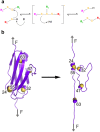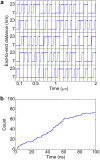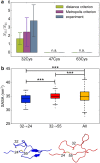Accessibility explains preferred thiol-disulfide isomerization in a protein domain
- PMID: 28851879
- PMCID: PMC5575259
- DOI: 10.1038/s41598-017-07501-4
Accessibility explains preferred thiol-disulfide isomerization in a protein domain
Abstract
Disulfide bonds are key stabilizing and yet potentially labile cross-links in proteins. While spontaneous disulfide rearrangement through thiol-disulfide exchange is increasingly recognized to play an important physiological role, its molecular determinants are still largely unknown. Here, we used a novel hybrid Monte Carlo and Molecular Dynamics scheme to elucidate the molecular principles of thiol-disulfide exchange in proteins, for a mutated immunoglobulin domain as a model system. Unexpectedly, using simple proximity as the criterion for thiol-disulfide exchange, our method correctly predicts the experimentally observed regiospecificity and selectivity of the cysteine-rich protein. While redox reactivity has been examined primarily on the level of transition states and activation barriers, our results argue for accessibility of the disulfide by the attacking thiol given the highly dynamic and sterically demanding protein as a major bottleneck of thiol-disulfide exchange. This scenario may be similarly at play in other proteins with or without an evolutionarily designed active site.
Conflict of interest statement
The authors declare that they have no competing interests.
Figures





Similar articles
-
Electrostatic interactions contribute to the control of intramolecular thiol-disulfide isomerization in a protein.Phys Chem Chem Phys. 2021 Dec 1;23(46):26366-26375. doi: 10.1039/d1cp03129e. Phys Chem Chem Phys. 2021. PMID: 34792054
-
On the mechanism of spontaneous thiol-disulfide exchange in proteins.Phys Chem Chem Phys. 2018 Jun 13;20(23):16222-16230. doi: 10.1039/c8cp01325j. Phys Chem Chem Phys. 2018. PMID: 29863196
-
Thiol-Disulfide Exchange in Human Growth Hormone.Pharm Res. 2016 Jun;33(6):1370-82. doi: 10.1007/s11095-016-1879-3. Epub 2016 Feb 17. Pharm Res. 2016. PMID: 26887678 Free PMC article.
-
Thiol-Disulfide Exchange Reactions in the Mammalian Extracellular Environment.Annu Rev Chem Biomol Eng. 2016 Jun 7;7:197-222. doi: 10.1146/annurev-chembioeng-080615-033553. Epub 2016 Mar 17. Annu Rev Chem Biomol Eng. 2016. PMID: 27023663 Free PMC article. Review.
-
Global methods to monitor the thiol-disulfide state of proteins in vivo.Antioxid Redox Signal. 2006 May-Jun;8(5-6):763-72. doi: 10.1089/ars.2006.8.763. Antioxid Redox Signal. 2006. PMID: 16771668 Review.
Cited by
-
Positions of cysteine residues reveal local clusters and hidden relationships to Sequons and Transmembrane domains in Human proteins.Sci Rep. 2024 Oct 29;14(1):25886. doi: 10.1038/s41598-024-77056-8. Sci Rep. 2024. PMID: 39468182 Free PMC article.
-
Mechanisms of Disulfide Bond Formation in Nascent Polypeptides Entering the Secretory Pathway.Cells. 2020 Aug 29;9(9):1994. doi: 10.3390/cells9091994. Cells. 2020. PMID: 32872499 Free PMC article. Review.
-
A proximity-based in silico approach to identify redox-labile disulfide bonds: The example of FVIII.PLoS One. 2022 Feb 7;17(2):e0262409. doi: 10.1371/journal.pone.0262409. eCollection 2022. PLoS One. 2022. PMID: 35130281 Free PMC article.
-
1,3-Dichloroacetone: A Robust Reagent for Preparing Bicyclic Peptides.ACS Omega. 2020 Jan 17;5(4):1840-1850. doi: 10.1021/acsomega.9b03152. eCollection 2020 Feb 4. ACS Omega. 2020. PMID: 32039320 Free PMC article.
-
Impact of SARS-CoV-2 RBD Mutations on the Production of a Recombinant RBD Fusion Protein in Mammalian Cells.Biomolecules. 2022 Aug 24;12(9):1170. doi: 10.3390/biom12091170. Biomolecules. 2022. PMID: 36139010 Free PMC article.
References
Publication types
MeSH terms
Substances
LinkOut - more resources
Full Text Sources
Other Literature Sources

